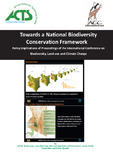| dc.description.abstract | Procceedings of the Biodiversity, Land Use and Climate Change conference, held on 15th to 17th September 2010 at Nairobi, Kenya, placed global biodiversity at US$ 33 trillion, measured as natural capital. This is higher than the world’s national products added together. Kenya hosts some of the world’s top-class biodiversity hotspot ecosystems (IUCN & UNEP 1986, Groombridge 1992, Burgess et al., 1998, Rathbun 2009). The country is home to some 35,000 described
species that provide livelihood to 80% of its human population. To put this into context,
an area such as the Taita Hills which is part of East African Arc Mountains is rated as
world top 25 biodiversity hotspots (Burgess et al., 1998). Recognizing the importance of
our natural capital, the Ministry of Environment, Ministry of Wildlife and Forests and twenty
conservation bodies, businesses and donors sponsored this conference on Biodiversity,
Land Use and Climate Change. The conference marks Kenya’s participation in the United
Nations International Year of Biodiversity 2010. | en_US |

